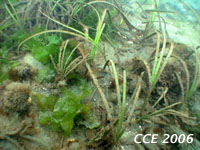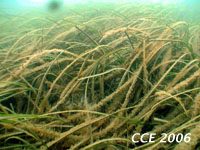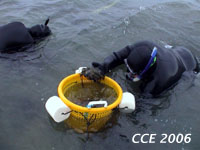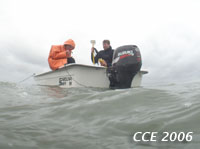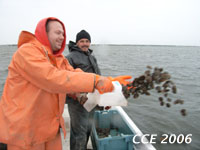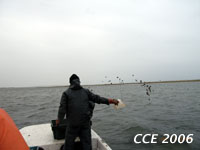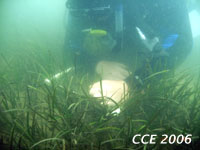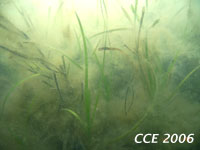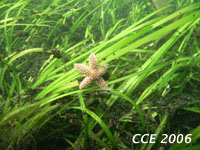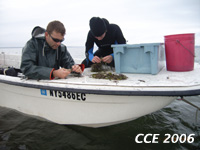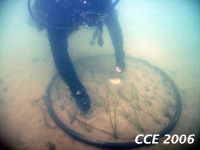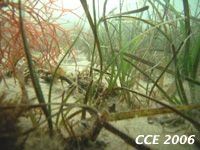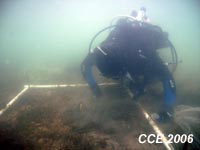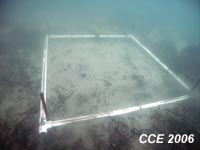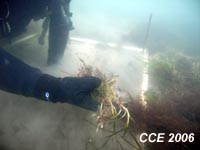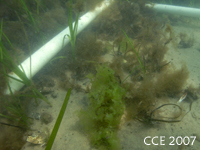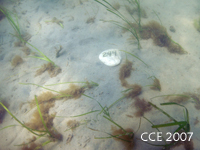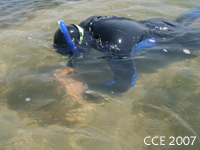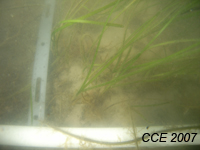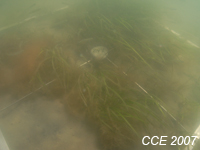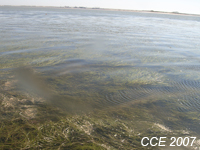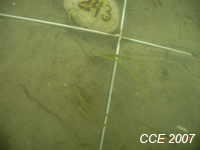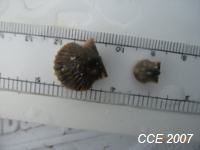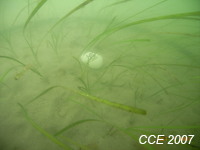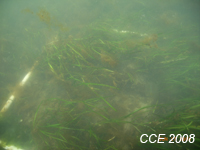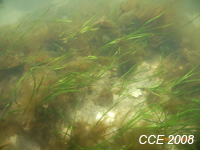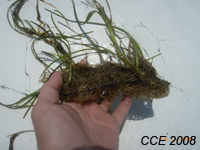South Shore Estuary Eelgrass and Bay Scallop Restoration Planning Project
Field Notes/ Work Completed
<<Back to SSE Project Overview
<<Back to Current Projects
November 2005 Initial
observations and mapping of existing eelgrass beds began in November.
Eelgrass observation locations included "East" and "West"
Points, Tiana Bay, north of Warner Island, and west of Gull Island. Later
in the month, a small amount of eelgrass was harvested from Gull Island
for grow out in the greenhouse. |
|
|
|
21Nov2005- The grass at East Pt was
small and patchy.
|
21Nov2005- The grass in Tiana Bay was
much larger and more dense. |
29Nov2005- Using snorkel gear, we harvested
plants from our Gull Island site. |
May 2006 Work
in May included the placement of temperature loggers as well as phase
1 of the scallop planting. |
|
|
|
2May2006- Steve
and Kim taking note of the location of the temperature logger north of
Warner Island. |
9May2006- Michael Patricio,
CCE's hatchery manager, happily distributing scallops into Shinnecock
Bay. |
9May2006- Gregg Rivara,
Aquaculture specialist, scatters scallops into Shinnecock Bay.283 |
June 2006 Further
eelgrass characterization was conducted in June throughout Shinnecock
Bay. This included shoot densities, canopy heights, and sediment sampling
at several meadows as well as the identification of additional meadows
throughout the bay using aerial photographs for reference. Site characteristics
including plant phenology, algal cover (macro and epiphytic), and other
metrics varied significantly depending on the water depth and proximity
to ocean influx of that particular site. |
|
|
|
30June2006- Steve conducting
his density counts at a site east of Shinnecock Inlet.
|
30June2006- Note the amount
of epiphytes and the poor water clarity at this site off of the Coast
Guard Station.
|
30June2006- In comparison,
this site, in which our temperature logger is located, has very clean
grass and a large amount of mussel spat and juvenile sea stars. |
November 2006 Test
plantings occured in November at two potential restoration sites in Shinnecock
Bay. Both test plots occured in areas with neighboring natural eelgrass
meadows, from which the transplants were collected. Our first test plot
location is east of Shinnecock Inlet in the southern part of the bay. The
second test plot location is located west of the Ponquogue Bridge, just west
of Gull Island. Each transplant location included 5 plots of a higher density
(100 planting units per square meter) and 5 plots of a lower density (12
planting units per square meter). "Planting units" were used instead
of individual shoots because of the large number of lateral shoots present
and the extremely small size of the plants. Each unit was composed of approximately
2 shoots. Observations of epiphyte load, number of lateral shoots, and the
presence of scallops were made at each of the natural meadows as well. Sample
shoots from each location were taken back to the lab for analysis. |
|
|
|
15Nov2006- Shoots collected from the natural
meadows were sorted and counted prior to planting. |
15Nov2006- A test plot being planted at
a density of 100 planting units per m². |
15Nov2006- A underwater view of the natural
meadow west of Gull Island. |
December 2006 We
conducted clearance plots and checked on our November plantings. Three 1m²
plots were cleared of all eelgrass (which we saved for counting and analysis).
These plots will be observed over time to determine the rate of natural
recruitment. |
|
|
|
22Dec2006- Diver Kim Petersen clearing
plot.
|
22Dec2006- A finished clearance plot.
These were staked and GPS coordinates were taken of each for future location. |
22Dec2006- Diver Steve Schott collecting
eelgrass from one of the clearance plots. |
June 2007 Clearance plots conducted in December '06 and plantings conducted in November '06 were revisited. There was some recruitment back into the cleared plots, though not substancial. November plantings were located and analysed as well, with the majority of plantings still remained and looked healthy. In late June, observations of patchy meadows in the shallows were conducted for a patch dynamics study. Small patches were counted and GPS coordinates were taken for relocation later. Also, flower shoots were collected for potential future seeding efforts in restoration areas. |
|
|
|
7June07- Natural recruitment into a clearance plot since December '06. |
7June07- November planting 244 remained and was healthy as with other plantings.
|
26June07- Steve Schott counting a small natural patch of eelgrass in the shallows east of the inlet. |
Sept 2007 Clearance plots conducted in December '06 and plantings conducted in November '06 east of the inlet were revisited once again. There was more recruitment into the cleared plots since June, in some areas the eelgrass grew over 1 foot into the cleared plot. November plantings were located, photographed, and observed as well, with the majority of plantings looking healthy and many had put on significant growth and had expanded. |
|
|
|
25Sept07- Natural recruitment into a clearance plot since December '06. Note the 12 inch ruler for size reference. |
25Sept07-Planting 244 (see above) grew significantly since June.
|
25Sept07- Due to the exceptionally low tide, we were able to photograph from above water significant prop-scarring in natural eelgrass meadows off of Warner Island. |
October 2007 Test plantings west of the inlet were revisited and observed. These plantings didn't take as well to the transplant as did those east of the inlet, but those transplants that were present were healthy. A new transplant was conducted in the northeast corner of Shinnecock Bay, near the mouth of Far Pond. Five circle plots (1 square meter in size each) were planted, each with densities of 100 shoots. Two tiny bay scallops were found on the eelgrass that was collected for transplant to the new planting site (see photo: note cm on top, inches on bottom for size ref.). The water clarity was poor throughout most of the bay. |
|
|
|
3Oct07- Planting west of inlet. |
3Oct07- Juvenile bay scallops found in natural meadow.
|
3Oct07-One of 5 new plantings near Far Pond. |
June and July 2008 Transplants and clearance plots east of the inlet were revisited and observed. Two of the clearance plots had filled in nearly 100%, and one was about 50% filled in, but a large colony of tube-dwelling worms may have prevented further recruitment into that plot. The transplants had expanded dramatically since our last visit, to the point we had a hard time telling the difference between the nearby natural grass patches and our transplants until our transplant markers were located. The center photo below shows planting #244 which is also shown in June and Sept. '07, and clearly has expanded considerably. We also found a fair amount of floating eelgrass, especially in the Northeast portion of the bay, probably uprooted due to "easing" or "churning" activity because the rhizomes were still completely intact. We looked for our plantings near Far Pond, but unfortunately we believe these were lost to shellfishing activities as well because the bottom had large, deep scars throughout the area where we had planted. Eelgrass flower shoot collection for seeds occurred on June 30 and July 1. |
|
|
|
17June08- Natural recruitment into a clearance plot from December. |
17June08- November plantings remained and were healthy and expanded considerably. This is plot #244 also seen in June and Sept '07 photos.
|
17June08- One of the floating clumps of eelgrass found in the bay with rhizomes still intact. |
|

